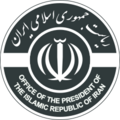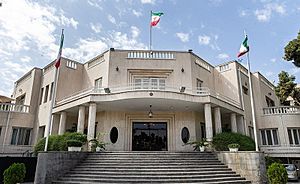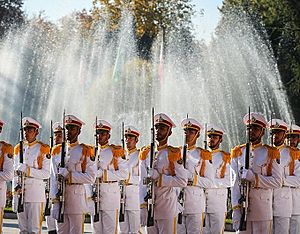President of Iran facts for kids
Quick facts for kids President of theIslamic Republic of Iran |
|
|---|---|

Seal of the Presidential Administration of Iran
|
|
| Presidential Administration | |
| Style | Mr. President |
| Member of |
|
| Residence |
|
| Seat | Pasteur, Tehran |
| Appointer | Direct vote |
| Term length | 4 years, renewable once consecutively |
| Formation | 4 February 1980 |
| First holder | Abolhassan Banisadr |
| Deputy | First Vice President |
| Salary | 2155 USD annually (538,592,400 ﷼)(as of 2019) |
The president of the Islamic Republic of Iran (Persian: رئیسجمهور ایران, romanized: Rais Jomhure Irān) is the head of government of the Islamic Republic of Iran and the second highest-ranking official, after the supreme leader. The first election was held in 1980 and was won by Abulhassan Banisadr. Masoud Pezeshkian currently serves as the president of Iran, after being elected in the 2024 Iranian presidential election and being officially endorsed by the supreme leader.
Contents
History
After the Iranian Revolution of 1979 and 1979 Iranian Islamic Republic referendum on March 29 and 30, the new government needed to craft a new constitution. Supreme Leader Ruhollah Khomeini, ordered an election for the Assembly of Experts, the body tasked with writing the constitution. The assembly presented the constitution on October 24, 1979, and Supreme Leader Ruhollah Khomeini and Prime Minister Mehdi Bazargan approved it.
The 1979 Constitution designated the supreme leader of Iran as the head of state and the president and prime minister as the heads of government. The post of prime minister was abolished in 1989.
The first Iranian presidential election was held on January 25, 1980, and resulted in the election of Abulhassan Banisadr with 76% of the votes. Banisadr was impeached on June 22, 1981, by Parliament. Until the early election on July 24, 1981, the duties of the President were undertaken by the Provisional Presidential Council. Mohammad-Ali Rajai was elected president on July 24, 1981, and took office on August 2. Rajai was in office for less than one month because he and his prime minister were both assassinated in a bombing. Once again a Provisional Presidential Council filled the office until October 13, 1981, when Ali Khamenei was elected president.
The election on August 3, 2005 resulted in a victory for Mahmoud Ahmadinejad. The election on June 12, 2009 was reported by government authorities as a victory for Mahmoud Ahmadinejad, the incumbent candidate, although this is greatly disputed by supporters of rival candidates, who noted the statistical anomalies in voting reports and large-scale overvoting in the officially announced tallies.
Ali Khamenei, Akbar Hashemi Rafsanjani, Mohammad Khatami, Mahmoud Ahmadinejad and Hassan Rouhani were each elected president for two terms.
The most recent president of Iran was Ebrahim Raisi. He succeeded Hassan Rouhani, who served eight years in office from 2013 to 2021. On May 19, 2024, a helicopter carrying Raisi crashed in the East Azerbaijan Province of Iran. There were no survivors at the crash site. Raisi was the second president of Iran to have died in office. Taghi Rahmani, the husband of detained activist and Nobel laureate Narges Mohammadi, said Raisi's death would not structurally change the Iranian leadership under Khamenei. Following his death, first vice president Mohammad Mokhber was designated as acting president until new elections could be held on 28 June.
Office
The president is required to gain the supreme leader's official approval before being sworn in by the Parliament, and the supreme leader has the power to dismiss the elected president if he has either been impeached by Parliament or found guilty of a constitutional violation by the Supreme Court. The supreme leader holds all the power. The president answers to the supreme leader, who functions as the country's head of state, and executes his decrees. Unlike the executive in other countries, the president of Iran does not have full control over the government, which is ultimately under the direct control of the supreme leader. Before elections, nominees to become a presidential candidate must be approved by the Guardian Council. Members of the Guardian Council are chosen by the supreme leader. The president of Iran is elected for a four-year term by direct vote and is not permitted to run for more than two consecutive terms.
Chapter IX of the Constitution of the Islamic Republic of Iran sets forth the qualifications for presidential candidates. The procedures for presidential election and all other elections in Iran are outlined by the supreme leader. The president functions as the executive of the decrees and wishes of the supreme leader, including: signing treaties with foreign countries and international organizations; and administering national planning, budget, and state employment affairs.
The president appoints the ministers, subject to the approval of Parliament and the supreme leader, who can dismiss or reinstate any of the ministers and vice presidents at any time, regardless of the president or parliament's decision. The supreme leader also directly chooses the ministers of defense, intelligence, foreign affairs, and interior, as well as certain other ministries, such as the Science Ministry. Iran's foreign policy is directly controlled by the office of the supreme leader, with the Ministry of Foreign Affairs' role limited to protocol and ceremonial occasions. All of Iran's ambassadors to Arab countries, for example, are chosen by the Quds Corps, which reports directly to the supreme leader.
The current supreme leader Ali Khamenei, ruling Iran for more than three decades, has issued decrees and made final decisions on economy, education, environment, foreign policy, national planning, and almost everything else in the country. Khamenei has also made final decisions on the degree of transparency in elections in Iran, and has fired and reinstated presidential cabinet appointments.
Qualifications and election
The procedures for presidential election and all other elections in Iran are outlined by the supreme leader. The president of Iran is elected for a four-year term in a national election by universal adult suffrage by everyone of at least 18 years of age. Presidents can only be reelected once if in a consecutive manner. Candidates for the presidency must be approved by the Council of Guardians, which is a twelve-member body consisting of six clerics selected directly by Iran's supreme leader (who may also dismiss them and replace them at any time), and six lawyers proposed by the supreme leader–appointed head of Iran's judicial system and subsequently approved by the Majles. According to the Constitution of Iran candidates for the presidency must possess the following qualifications:
- Iranian origin;
- administrative capacity and resourcefulness;
- a good past record;
- trustworthiness and piety; and
- convinced belief in the fundamental principles of the Islamic Republic of Iran and the official madhhab of the country.
Within these guidelines the council vetoes candidates who it deems unacceptable. The approval process is considered to be a check on the president's power, and usually amounts to a small number of candidates being approved. In the 1997 election, for example, only four out of 238 presidential candidates were approved by the council. Some Western observers have routinely criticized the approvals process as a way for the council and supreme leader to ensure that only conservative and like-minded Islamic fundamentalists can win office. The council denies this, citing approval of Iranian reformists in previous elections. The council rejects most of the candidates stating that they are not "a well-known political figure", a requirement by the current law.
The president must be elected with a simple majority of the popular vote. If no candidate receives a majority in the first round, a runoff election is held between the top two candidates.
The president automatically becomes the Head of the Supreme National Security Council and the Head of the Supreme Council of Cultural Revolution.
Legality of a woman to be candidate
The legality of women running for presidency depends upon the meaning of one of the criteria the candidate is required to fill. The 115th article of the Iranian constitution states that the president must be elected from among "religious and political men" or "religious and political personalities", depending on the interpretation (Persian: رجال مذهبی و سیاسی, romanized: rejāl-e mazhabi va siāsi). In 1997, the Guardian Council used the first interpretation to reject the candidature of Azam Taleghani, the first woman to run for presidency. However, before the 2021 presidential election, the guardian council's spokesman said that legally there is no impediment for a woman to be president.
Inability
According to the article 131 of the Iranian constitution, "In case of death, dismissal, resignation, absence, or illness lasting longer than two months of the President or when his term in office has ended and a new president has not been elected due to some impediments, or similar other circumstances, his first deputy shall assume, with the approval of the Leader, the powers and functions of the President. The Council, consisting of the Speaker of the Islamic Consultative Assembly, Chief Justice, and the first deputy of the President, is obliged to arrange for a new President to be elected within a maximum period of fifty days. In case of death of the first deputy to the President, or other matters which prevent him to perform his duties or when the President does not have a first deputy, the Leader shall appoint another person in his place."
Powers and responsibilities
The president's duties include the following, subject to supervision, policy guidance and approval by the supreme leader:
- Second in command (after the supreme leader) of the executive branch of government and chairperson of the cabinet
- The deputy commander-in-chief of the Islamic Republic of Iran Army
- Declares a state of emergency after passage by the parliament (The proclamation of martial law is forbidden.)
- Heads the Supreme National Security Council
- Heads the Supreme Council of the Cultural Revolution
- Appoints the first vice president of Iran and other vice presidents
- Nominates of Cabinet members to the Parliament
- Sends and receives all foreign ambassadors
- Issues decrees
- Issues medals in honor of service for the nation
- Signs treaties, protocols, contracts, after parliamentary approval
- Signs referendum results and legislation approved by parliament and the judiciary
Latest election
| Candidate | Party | First round | Second round | ||||
|---|---|---|---|---|---|---|---|
| Votes | % | Votes | % | ||||
| Independent | Reformists | 10,415,991 | 44.36 | 16,384,403 | 54.76 | ||
| Independent | Principlists | 9,473,298 | 40.35 | 13,538,179 | 45.24 | ||
| Progress and Justice Population of Islamic Iran | Principlists | 3,383,340 | 14.41 | ||||
| Combatant Clergy Association | Principlists | 206,397 | 0.88 | ||||
| Total | 23,479,026 | 100.00 | 29,922,582 | 100.00 | |||
| Valid votes | 23,479,026 | 95.70 | 29,922,582 | 98.01 | |||
| Invalid/blank votes | 1,056,159 | 4.30 | 607,575 | 1.99 | |||
| Total votes | 24,535,185 | 100.00 | 30,530,157 | 100.00 | |||
| Registered voters/turnout | 61,452,321 | 39.93 | 61,452,321 | 49.68 | |||
| Source: ISNA, IranIntl, Tejarat News | |||||||
See also
 In Spanish: Presidente de Irán para niños
In Spanish: Presidente de Irán para niños
- List of presidents of Iran
- Advisor to the President of Iran
- Aide to the President of Iran
- Chief of Staff of the President of Iran
- First Lady of Iran




